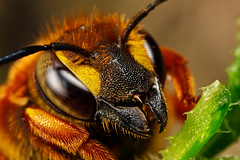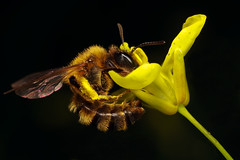Let's start out with a shot of a Cuckoo Bee taken at five times life size, F10, and ISO 100:

What if I told you that taking an image like that one, hand held, is easy? Here's the setup: I found this bee on a cool, partly cloudy, day when it was just starting to get active. Since the temps and light were low it was really lethargic -so slow that I was able to cut the plant it was on with a small pair of scissors that I carry in my camera bag and move it to a shaded area on top of a stone wall (to keep it from warming up and flying off). I then clamped the stem of the plant into a small wood clamp that I also carry in my bag and I've got an instant studio. I simply rotated the plant to get the angles that I wanted and rested my arms against the wall to keep everything steady. Granted I had to nail the composition and the focus, but it's really just a matter of practice...
Same critter, but this time at 3x, F13, and ISO 100:

Notice how the background isn't black? That's because I've got the critter as close to the surface of the stone wall as I can and I'm shooting from an angle that allows me to illuminate the wall with the flash -there is no natural light in that scene. Easy to do because I'm in full control of the frame and how the elements in it are arranged. Seriously once you get past the mechanics and understand how things work then an image like that one isn't difficult -it only looks hard due to the magnification.
In contrast here's a shot at life size, F13:, and ISO 100

The background is black because it has to be: I'm shooting in an unkempt flower bed that's less than half a meter wide. The wall behind the bee is dirty and too far away to be illuminated by the flash. I could crank up the ISO or even lower the shutter speed to get some ambient light into the scene (it's almost noon on a cloudless day) but there's one little problem -the bee is hyper active. Even though it doesn't take me long to focus and shoot this little guy gave me all of three frames and he was in constant motion. The only way I could get a sharp image is to take full control of the light and freeze the motion in the scene with the short duration of the flash -to literally use the flash as my shutter. If the flash didn't fire then the only image I'd have is a little bit of that yellow flower (the bee would have been a silhouette).
The same principals hold true for this shot of a honeybee at life size, F13, and ISO 100:

The flower in the background? Well I saw it in the view finder and framed the scene to get it, but the fact that it shows up in the image is luck. It just happened to be close enough to be lit by the flash. Of the four images in this post the last two were the hardest to take since the critters in both of them are in motion.
Footnote: I intentionally left out the shutter speeds that I used for those images because the shutter only effects the amount of ambient light that makes it to the image plane and it has no effect on the flash (as long as you're shooting at or below your camera's flash sync speed). The point that I'm trying to make by not including the shutter speed is that it doesn't matter when shooting at macro magnification and high Fstops -there just isn't enough natural light making its way into the lens to have a major effect on what the camera records. Also by shooting at high Fstops and ISO 100 I'm intentionally trying to eliminate the ambient light in the scene so I can take full control of the light with the flash. So when you look at my images you're really viewing a form of stop motion photography where I'm freezing the motion in the scene with a short duration flash pulse -and now you know the secret to my sharp images... ;)

13 comments:
You know, I've read you describe your techniques for shooting macro for as long as I've had your blog in my RSS reader, and your description in this one finally made the flash portion of it "click" with me. In all practical respects, your flash is your shutter; at 5x, there's so little light actually getting through that MP-E that your real shutter speed (almost) doesn't matter.
As long as you have enough flash. :-)
Thank you for writing these articles, John; they're incredibly helpful for amateurs like me who would like to do better.
Glad to help!
Actually, above life size magnification, the duration of the flash is my shutter speed -there is no ambient light reaching the sensor...
Thanks for a yet again nice post! :) I've been reading this stuff ever since you opened the blog. You might be familiar with me from before.
I just posted to ask you a question about reflecting subjects. Let's say an ordinary green bottle fly is something i want to shoot and i've got the MT-24EX + MP-E. It's a hard task by itself because those scare off very easily compared to other flies imo. The main problem that im having is that the fly will come out completely black with just a hint of it's real tone (bright green). Is there any way to light the fly so that it would come up as it looks with natural light? I've tried almost everything and only on random occasions i'll get it to look it 'should'.
Could it be that my flash is so dominent compared to natural light and the only way to fix this is bump the ISO (to gather more natural light) and also use smaller magnification?
Any help regarding all kinds of reflecing bugs is appreciated :)
My guess is that you're shooting at or below 2x and / or at a high angle, but I need to know for sure before I answer your question laxative.
I mostly shoot at 3 times life size and further (smaller magnification)
I've tried various angles and they all end up the same, a black mess with very little details.
Make sure that you have both flash heads pointed all the way down toward the lens. With the MPE-65mm the general rule of thumb is to push the flash heads all the way down toward the lens when shooting from 2x to 5x, and one "click" up from all the way down when shooting at life size.
Odd that you'd have a problem at 3x, since the subject should fill most of the frame at that mag. You will run into trouble shooting dark subjects at low mag against bright backgrounds since E-TTL metering will err on the side of caution and expose for the background. I usually shoot at low angles at all mags so I avoid problems with bright backgrounds for the most part.
Hmm. Thanks for the tips! :) I'm actually shooting with the flashheads exactly like you've got on your previous 'tutorial'. One flash head at 11 o'clock and another at 3 o'clock with the one on top pointed one click upwards :)
Constantly learning. The shiny bugs really annoy me. I'm having great trouble with ants too. The exposure never comes out like it should :)
It takes a lot of practice to tame the MT-24EX, but it's worth it...
I sometimes use one flash head on an extender, but if I'm shooting above life size then both flash heads are pointed all the way down toward the lens.
Ahh, i though you would raise one head up one 'click' also on higher magnifications! :) It sure does take alot to get used to the flash.
My sto-fen OM-24EX's appeared today after all. Theres not a single fly around and you cant imagine how pissed i am about that!
I'm actually pretty much using the same setup as you. I made a quick 'flash extender' like yours from my cheap cactus ebay triggers. They lift the other flashead up just like your contraption! I'm such a copycat ;-)
Yet again, thanks for the blog. I think i'll read your new post now! :)
No wait! You're using a 40D and i'm using a 5D. I will never be able to get as close as you :(
Every time I get a new toy it rains :)
Macro is one area where having a crop factor camera comes in handy.
Great blog, and lots of useful information. I am fairly new to macro photography, but your guides are very helpful. It can be very frustrating when trying to photograph the little critters and I am sure my neighbours think I am made chasing things around my garden with my camera attached to my face.
Thanks again.
Thanks Mark!
Remember: There are only two types of people who squat down and rock back and forth -crazy people and macro shooters trying to focus a scene... :D
Post a Comment